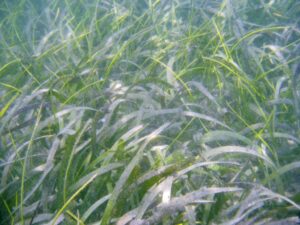In a treatise, professor and seagrass ecologist/physiologist Dr. Richard Zimmerman reflects on the history of seagrass ecosystems research and contemplates the future of seagrasses under human disturbance and a changing climate. This article is part of a special journal issue to honor deceased seagrass researcher Dr. Susan L. Williams.

Seagrass ecosystems continue to suffer from resource extraction, coastal development, waste dumping, and global impacts from climate warming, sea level rise, and ocean acidification. Collectively, these forces are creating a global crisis that threatens the survival of seagrass meadows, as well as, shellfish and coral reefs that create essential habitat for coastal ecosystems worldwide. Although global implications of these habitat losses are dire, sustained local/regional efforts to improve and maintain water quality based on sound science have produced encouraging results
In the paper, some interesting facts regarding seagrass research are discussed. For example, seagrasses are relatively weak competitors for light compared with their macroalgae counterparts, and that seagrass light requirements can be approximated by easy-to-measure Secchi disk depth, which has provided a management tool to link seagrass survival to water transparency and nutrient loading into coastal waters. Improving water transparency has been important in the recent recovery of seagrass systems in Chesapeake Bay, Tampa Bay and Sarasota Bay.
Regarding ocean acidification, light and carbon dioxide (CO2) represent independent, but potentially co-limiting drivers of photosynthesis such that the impact of ocean acidification on seagrasses will depend strongly on the light environment in which the plants are grown. Photosynthesis of most marine plants and algae exhibit little impact to ocean acidification because their CO2 concentrating mechanisms effectively facilitate the extraction carbon dioxide from bicarbonate, which is 140 times more abundant in seawater than free carbon dioxide, thereby maintaining a CO2-rich environment for growth.

This paper was supported in part by the NCCOS Ocean Acidification Program project “Can Meadows of Submerged Aquatic Vegetation (SAV) Mitigate Ocean Acidification Thresholds for Eastern Oysters in the Chesapeake Bay?”
Citation: Zimmerman, Richard C. 2020. Scaling up: Predicting the Impacts of Climate Change on Seagrass Ecosystems. Estuaries and Coasts Special Issue: Seagrasses Tribute to Susan Williams. https://doi.org/10.1007/s12237-020-00837-7
